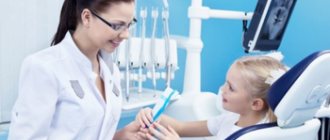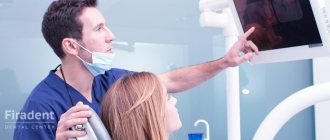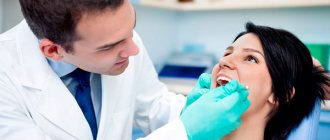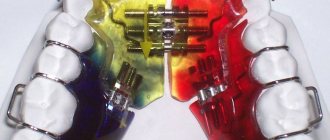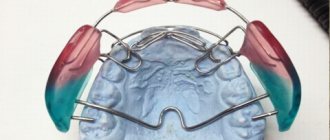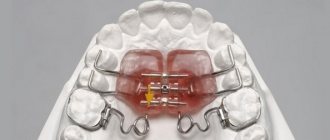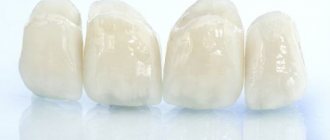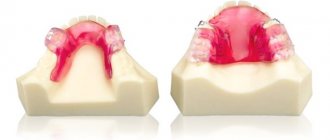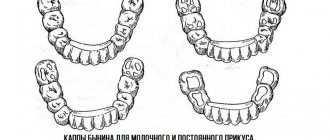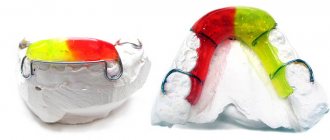7137
Modern orthodontics is designed to solve a person’s problems with the arrangement of individual teeth and the entire dentition as comfortably and quickly as possible.
Many patients are sure that only braces are used to straighten teeth, but this is not the case.
The Derichsweiler apparatus helps to expand the upper jaw and make a person’s smile smooth and beautiful.
Design and principle of operation
The Derichsweiler apparatus consists of elements :
- plate made of plastic or metal;
- metal screw;
- hooks, wire arches.
This design is located at the top of the palate, cast arches are attached to the side teeth, exerting pressure on them . The plate inside is equipped with a screw and metal fittings - hooks, which are fixed on the supporting molars.
Having securely fastened the device, the doctor looks at the effect it has on the teeth.
In addition to jaw expansion, there is also the movement of certain teeth that need correction.
During the treatment process, the design undergoes changes - a metal screw is tightened, which increases the area of the plate and increases the pressure.
The screw allows you to apply a gradually increasing load on the teeth, thereby fixing their displacement.
In addition to the problem of a narrow jaw, another, accompanying problem is solved - gaps between the teeth. As a result of pressure on the molars, incisors and premolars, these gaps are eliminated using springs and screws.
Classification
There are several types of irregularities in the shape of rows:
- Uniform narrowing. A visually elongated frontal segment is observed. The tight fit of the incisors to each other provokes a fan-shaped position.
- Clenched jaw. A saddle-shaped narrowing is formed in the area of molars and premolars. Reduced space in the jaw arch results in oral or buccal deviation of the masticatory units.
- Narrowing of the frontal zone. The arc has a V-shaped configuration. There is a tight fit to each other and anterior advancement of the incisors.
- Trapezoidal narrowing. The shape of the arc is similar to a trapezoid with 4 corners. Crowded incisors form a straight line. Lack of space leads to rotation of units.
- Uneven narrowing. Pathology is diagnosed in individual areas of the row and manifests itself in the form of crowding of units in a clearly defined area.
Indications for use
The Derichsweiler apparatus is necessary for patients who have the following problems :
- the upper jaw is too narrow, this is determined by the relationship between the upper and lower teeth, sometimes a person experiences difficulty chewing food, speaking and aesthetic discomfort;
- with crowding of molars, premolars in the upper jaw;
- in the presence of crossbite;
- if the fangs on the upper jaw grow incorrectly, out of place.
If these problems exist, dentists choose this particular device, as it allows you to effectively straighten your teeth in a short period of time .
Facebow
Used in adolescence in growing patients up to 12-13 years of age. The use of this device is effective in cases of predominant growth of the upper jaw and the goal of treatment on the face bow is to move the teeth in the upper jaw posteriorly.
Indications for use:
1. Distal bite. 2. Early loss of chewing milk teeth and displacement of the permanent 6 teeth. 3. To inhibit the growth of the upper jaw.
Wearing mode:
The orthodontist always recommends wearing it 24 hours a day. But in reality we're hoping for night, evening and weekend wear. Those. The face bow must be in the mouth for more than 12 hours a day.
Wearing period:
Most often, a facebow is prescribed together with a brace system (partial 4*2) or full. And it is used until the target is achieved (6-18 months).
Contraindications
The Derichsweiler apparatus is used up to the age of 20-23 years.
Its use is indicated for everyone who has the problems listed above. The only contraindication is an allergic reaction to metal or plastic that is part of the device.
It is not recommended to actively use it in case of cleft of the soft and hard palate, since with this defect an operation is performed to tighten the palatal suture, and the device just widens this suture.
In such a case, the treating orthodontist makes his verdict. After all, with this defect there are a lot of concomitant pathologies of tooth growth.
Advantages and disadvantages
In orthodontics, there are several methods for treating narrowness of the upper jaw.
But the Darichsweiler design has several advantages over them:
- the patient gets quick results, after a short treatment there is a noticeable expansion of the upper jaw;
- a person quickly gets used to the device, even if at first he experiences discomfort when wearing it;
- This device is used along with other methods of teeth straightening, for example, braces.
Using this mechanism, a person gets quick and high-quality results.
But when using it, patients sometimes experience complications. They are the disadvantage of this device.
When used in childhood, the child's palate may open. If you start treatment before the molars grow, you can avoid negative consequences.
This is due to the fact that in early childhood the palatine lobes have not yet completely fused, which allows for a good result to be achieved.
Face-Mask
The facial mask ( Dilyara ) belongs to the category of auxiliary extraoral orthodontic appliances that are used to treat mesial occlusion in childhood and early mixed dentition.
There are several most common types of face masks used to correct malocclusion: Dilyar's mask, Tubinger's mask, Petit's mask. All face masks differ only in design features, they relate to the size, type and points of attachment of the mask on the face, but have the same purpose - to correct the bite. Their action is based on the formation of extraoral horizontal and mesial traction, which affects the growth of the upper jaw, thereby “stretching” the jaw.
A face mask is prescribed in the following cases:
1. The profile of the face should be concave (protruding chin, receding upper lip) 2. Early age, since the most effective use of the mask is in the primary and early mixed dentition;
The face mask is a metal frame containing two supports that are placed on the patient's chin and forehead and are combined with elastic traction. The face mask is used in combination with a plate and hooks for traction, or a brace system.
Benefits of face masks
1. Easily removable outer part of the mask. 2. Easy to remove the thread after use. 3. Easy care of the device (the lightness and elegance of the entire structure, which allows you to feel the mask on your face no worse than glasses on your nose, the support pads do not cause irritation and allergic reactions). 4. High efficiency of the entire structure.
Disadvantages of the device
The only significant drawback of extraoral appliances is the impossibility of their round-the-clock use. The effectiveness of treatment depends on compliance with wearing a mask. On average, treatment using a face mask takes 2-4 months when wearing it 12-16 hours a day.
Manufacturing process
To manufacture the device, you need to perform some manipulations with a doctor.
- At the first consultation, the specialist takes an impression of the teeth, which must be done very carefully, because the effectiveness of the treatment and the duration of the patient’s adaptation depend on this.
- First, the deepest part of the palate and torus is isolated, for which the doctor makes a gasket, no more than 4.5 mm in thickness.
- The interdental papillae of the gums and the front part of the palate are relieved of pressure.
- The plate itself is made of transparent plastic, which greatly facilitates the process of correction and monitoring the state of the sky under the plate.
- After fitting the device to the patient, the device is checked on a plaster model of the jaw, and the ability of the screw to work is assessed.
We will tell you how the Brückl-Reichenbach apparatus works in a separate article.
In this publication we will compare the appearance of diastemas before and after therapy.
Here https://orto-info.ru/sistemyi-vyiravnivaniya-zubov/breketyi/po-raspolozheniyu/vestibulyarnyie/victory.html you will find a review and photo of Victory braces.
Installation sequence
The accuracy of installation of the mechanism is important for the patient, because he will feel a foreign body in the oral cavity for at least another 3 months.
Treatment takes place in several stages:
- After checking the screw mechanism and adjusting the plate on the plaster jaw, the device is installed on the patient . The patient is given a day to master the device. At this time, he learns to use it and gets used to it.
- Then the patient, if nothing bothers him, has crowns and rings attached to his molars using special dental cement.
- 24 hours after fastening, the doctor begins the treatment process: the screw is unscrewed .
- Every day the screw is activated half a turn, the doctor and the patient monitor the condition of the device in the oral cavity and general well-being.
If the pain after turning the screw disappears within a minute, then you can continue treatment.
It is important not to overtighten the screw - this can lead to complications. If you add a little pressure, you may experience pain in the temples and bridge of the nose. In this case, the doctor returns the screw a little back.
After just a week, you can see the first result of the device - a diastema appears between the front teeth - a gap that grows and then goes away. There is a gradual alignment of the teeth.
Upon completion of treatment:
- the side teeth fall into place,
- the sky slightly increases its area,
- the lower part of the face visually becomes larger,
- the lower jaw falls into place,
- teeth align their position.
At what stage of bite correction is the Derichsweiler apparatus used, look at the video:
When the process of tightening the screw is completed, it is covered with a plastic plate for the patient’s convenience and to minimize discomfort.
Features of the use of the Marco Rosa apparatus in Dial-Dent
Family Dental Orthodontists have a comprehensive approach to correcting malocclusion in children, so the clinic employs an ENT doctor and a speech therapist who help eliminate the causes of malocclusion, thereby increasing the effectiveness and stability of orthodontic treatment.
If there are problems with nasal breathing, ENT doctor A.V. is involved in treatment. Arkhandeev. The participation of an ENT specialist in orthodontic treatment is very important, since without normalization of nasal breathing, the treatment result will not be stable and no device will help!
If there is improper muscle function, incorrect position of the tongue, infantile swallowing, if the mouth is constantly open, even when breathing through the nose, a speech therapist - myofunctional therapist T.B. takes part in the treatment of children. Zukor. Classes with a speech therapist normalize the tone of the facial muscles, eliminate excessive pressure of the tongue on the teeth, normalize swallowing and breathing - that is, they remove factors that provoke malocclusion.
See the price list of the clinic for the cost of the Marco Rosa device.
How long to wear?
During the consultation, the orthodontist determines the approximate timing depending on the degree of anomaly in the position of the teeth.
The process of tightening the screw can last from a week to 2-3 months. It also depends on the age of the patient and the process of adaptation to the device. If any complications arise during treatment, more time will be required for alignment.
After tightening the screw, a period of retention follows - maintaining the achieved result . This is a very important time, because if it is not organized correctly, all efforts come to nothing.
The device stays in the oral cavity for a total of 2-3 months.
Possible complications
Complications during treatment with the Derichsweiler apparatus include dehiscence of the palate suture . This occurs due to weak tissues or too much pressure on the teeth. Sometimes it is difficult to adjust the position of the screw correctly.
The occurrence of persistent pain is also a complication of treatment with this device.
Care instructions
Since the device is not removable, but is constantly in the oral cavity, it must be carefully looked after. Food debris accumulates between the wire and the teeth, forming plaque, which must be carefully cleaned with a medium-hard brush .
The patient periodically needs to visit the dentist or hygienist to clean all the hard-to-reach areas between the appliance and the teeth. The patient receives cleaning instructions each time a screw is tightened.
It is imperative to comply with the requirements for oral care, especially if other orthodontic systems are used together with the device.
In this case, it is better to rinse your mouth after each meal and not to eat hard, hard foods .
How is the Haas apparatus installed?
In fact, installing the device in the attending physician’s office is quite simple and does not take long:
- In a friendly atmosphere, we clean the enamel of plaque with a pleasant aromatic paste.
- We use dental glue - a safe cement - and fix the device onto the primary chewing teeth and canines.
- Excess filling material is removed and the interdental spaces are cleaned.
- The composite material becomes strong under the light of the lamp.
I use modern technologies and equipment; my child and I discuss the design of the device and the need for its installation as equals. Before the correction begins, together with the parents we discuss the problem and ways to solve it. Make an appointment and we will make sure your baby's teeth are perfect.
What is the price?
All individual designs have a fairly high price, because they are not produced on a conveyor belt, which means that their production takes more time and effort. The price for each patient depends on several criteria :
- material for making plates, crowns and rings;
- region of residence of the patient;
- prices for doctor's services, which are determined for each medical institution.
After the inspection, the specialist can tell you the approximate price for the device.
The device itself can be purchased at a price of 8,500 rubles .
But the total cost will also include consultation with a specialist, manufacturing of the mechanism and its installation. In addition, the patient comes to tighten the screw, which is also paid for.
How does crossbite manifest in children and what are the differences in the methods of influencing it?
In this article, we will discuss how much teeth straightening trays cost and what factors influence the price.
At the link https://orto-info.ru/zubocheliustnye-anomalii/okklyuzii/glubokiy-prikus.html we published a selection of photos of how the face changes with a deep bite.
